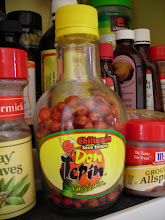Shortly after de Certeau's definition of "la perruque" or "the wig" (ie: making do in any given situation), he goes on to construct a model of consumption based off of strategies versus tactics. In the spaces created by "la perruque," individuals are able to become identifiable within these spaces and thus a person "establishes within it a degree of plurality and creativity. By an art of being in between, he draws unexpected results from his situation" (30). This creativity, I think, according to de Certeau, must be able to be manifested in consumption--in other words, the consumer must be given a sort of authorship in his or her situation or else, that person (and society risks the analogy de Certeau sets up between a child with his pens and crayons drawing in the margins of a book (and thereby adding to and authoring in his own uniqueness) versus a child viewing a television screen in which he or she is given no opportunity to participate: "He loses his author's rights and becomes, or so it seems, a pure receiver, the mirror of a multiform and narcissistic actor. Pushed to the limit, he would be the image of appliances that no longer need him in order to produce themselves, the reproduction of a 'celibate machine'" (31). I found this an interesting start to a thesis that is carried on throughout the book: de Certeau sets up the system of the consumer, by a tactical manner, to be one of movement and change: "Consumers are transformed into immigrants. The system in which they move about is too vast to be able to fix them in one place, but too constraining for them ever to be able to escape from it and go into exile elsewhere" (40). Therefore, by the time the reader comes to de Certeau's argument concerning reading and its effect of the "passive" reader, we have a wonderful metaphor to work with: that of the immigrant, wandering through the text, taking in its implications and modifying its object (169). In this sense, the reader "invents in texts something different from what they 'intended.' He combines their fragments and creates something unknown in the space organized by their capacity for allowing an indefinite plurality of meanings" (169). De Certeau goes on, however, to say that precisely because texts have this tendency toward plurality, "the text becomes a cultural weapon, a private hunting reserve, the pretext for a law that legitimizes as 'literal' the interpretation given by socially authorized professionals and intellectuals" (171). This reading, and interpretation/creativity through reading, seems to me to be the ultimate "perruque" preformed by the consumer against the system which is attempting to gain control. I'm wondering, then, if this reaction (what was originally set up as a tactic, or spontaneous response) is now becoming more and more of a consumeristic strategy? In other words, as more and more people become conscious of the technocrats' strategy, do they in turn lose their ability to simply "react" in tactical form (tactic implying, according to de Certeau, an unconscious response) and therefore begin, in some small way, to repeat the process? In other words, do the consumers eventually take the place of the technocrats, only to impose the same strategies on the next "unconscious" generation of consumers? How do we "make do" knowing we might just become "one of them?"
--Julie Lauterbach-Colby
Sunday, March 1, 2009
Subscribe to:
Post Comments (Atom)




No comments:
Post a Comment